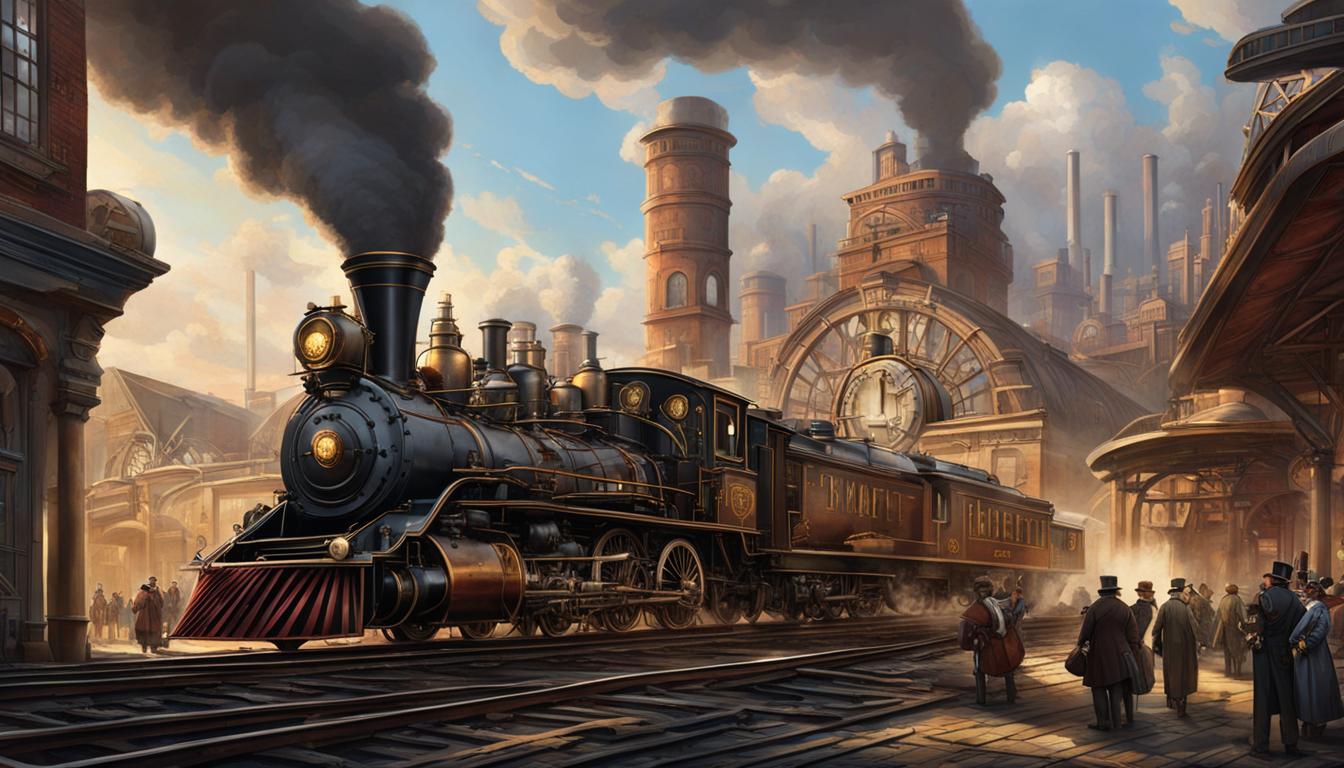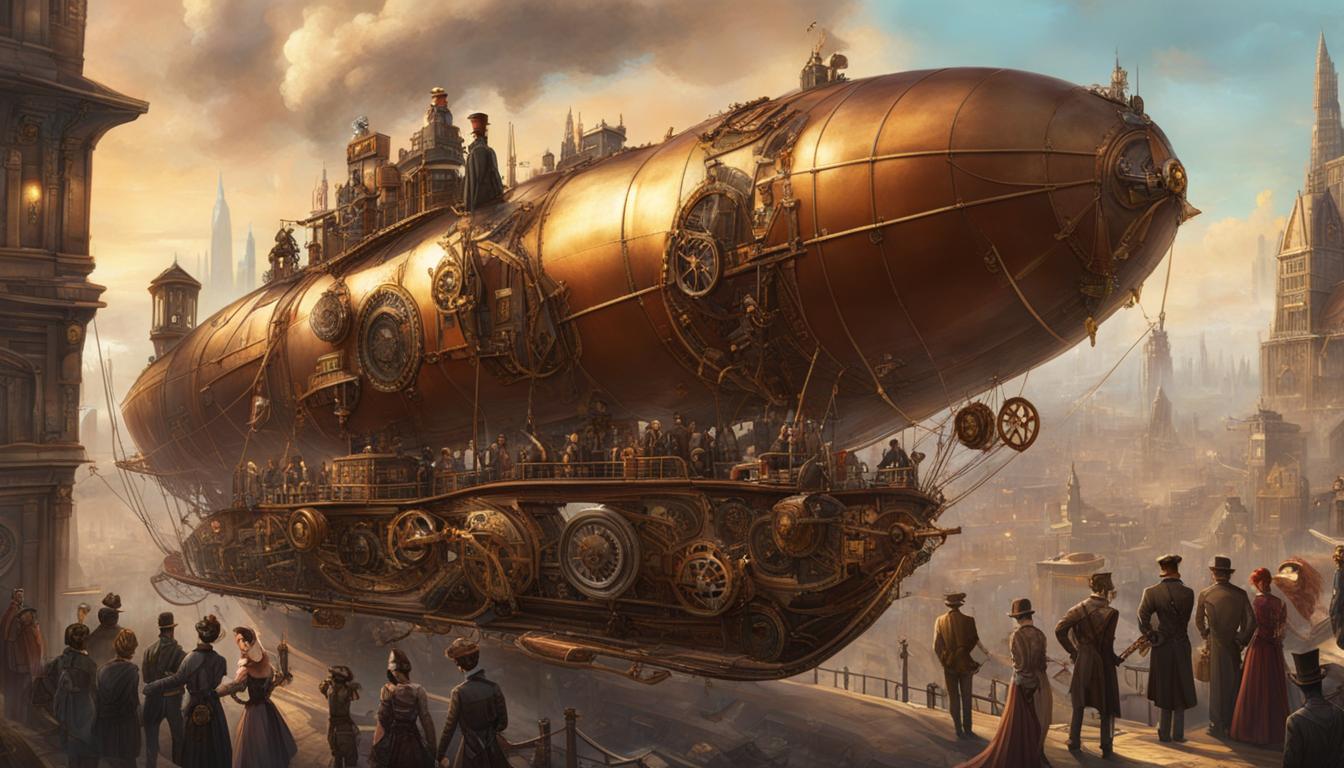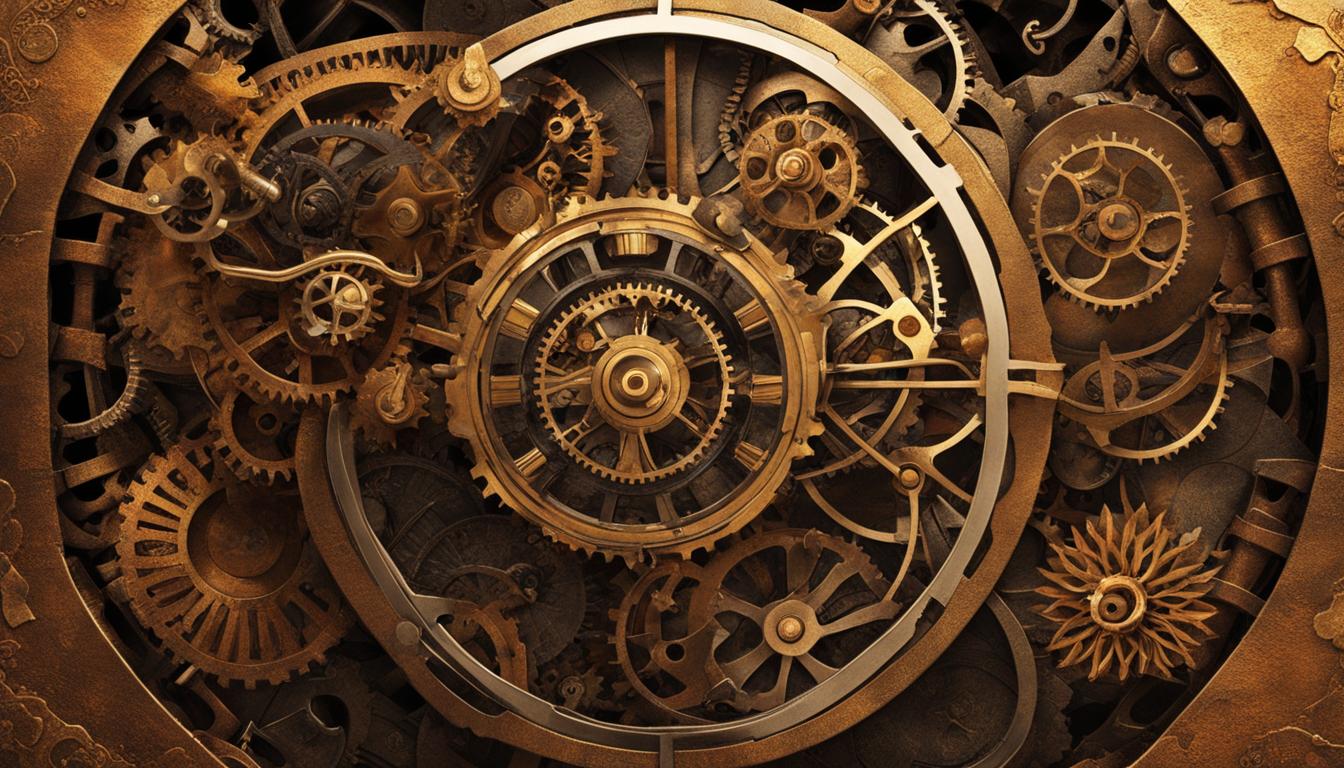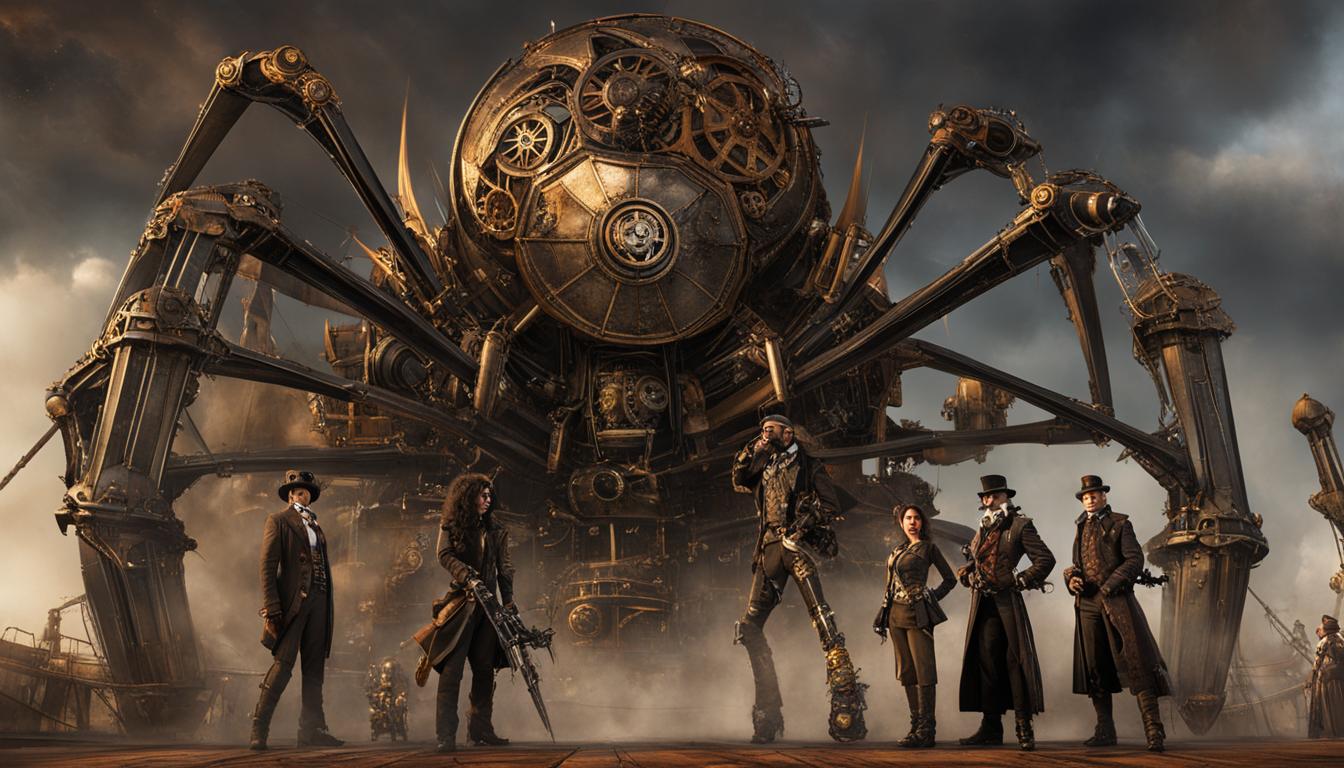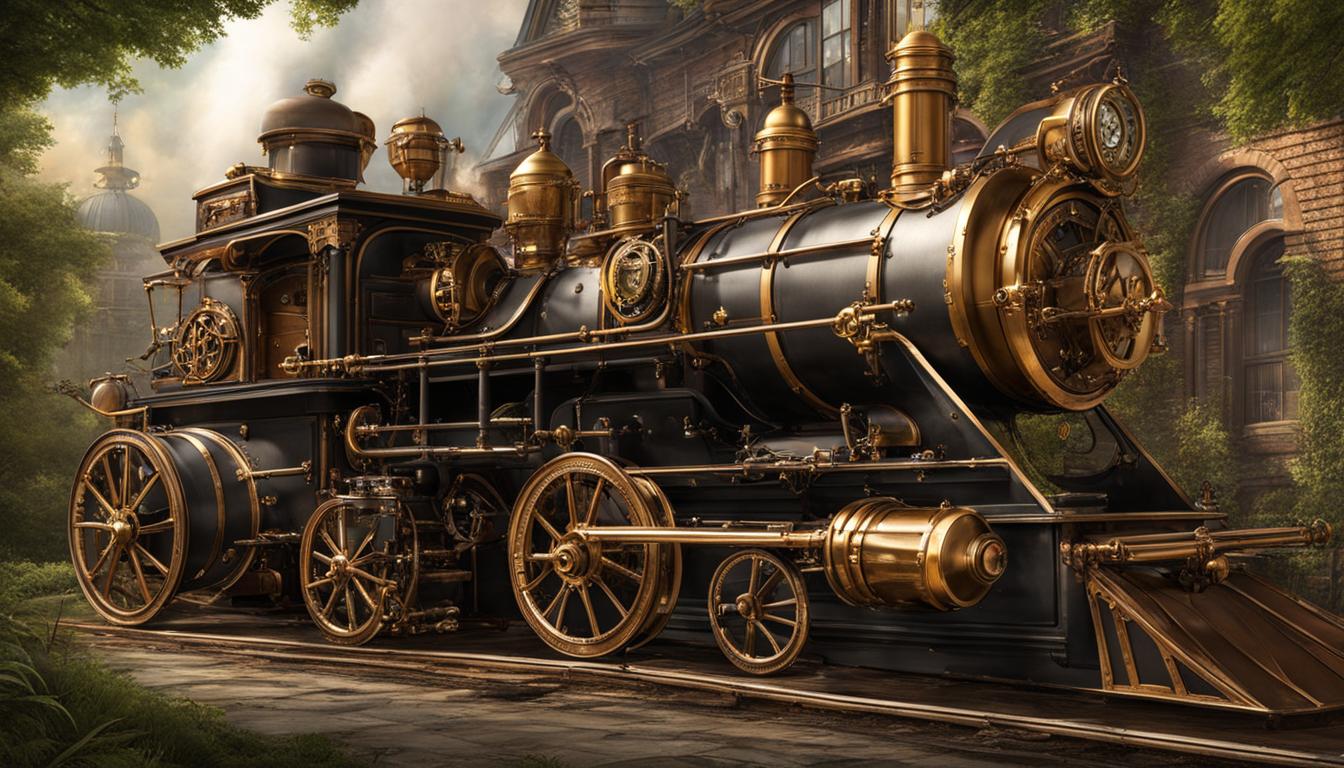Steampunk is a subgenre of science fiction that transports us to a world where retrofuturistic technology and Victorian aesthetics collide. But how did this captivating genre come to be? Let’s dive into the inception of steampunk, uncover its origins, and unravel the stories behind its emergence.
In the realm of steampunk, the past meets the future in a unique and imaginative way. It all started with the birth of the term “steampunk” in 1987, but its roots can be traced even further back to the works of fiction from the 1950s and earlier.
Early steampunk authors laid the foundation for this genre, weaving captivating tales that blended Victorian sensibilities with fantastical elements. These visionaries, such as H.G. Wells and Jules Verne, showcased advancements in technology and explored the possibilities of steam-powered machinery.
Steampunk is not only about storytelling; it’s also about aesthetics. The inception of steampunk aesthetics can be seen in the fusion of Victorian fashion, art, and architectural style. The synergy between technology and fashion creates a visual feast for the eyes, with gears, goggles, and lace parasols adorning the characters and settings.
The emergence of steampunk has had a profound impact on popular culture, inspiring the creation of countless novels, films, TV shows, and even video games. Its themes of Victorian England and the American “Wild West” continue to captivate audiences worldwide.
Key Takeaways:
- Steampunk originated in the late 20th century, with roots in earlier works of fiction.
- Key figures such as H.G. Wells and Jules Verne played a vital role in shaping the genre.
- The fusion of Victorian aesthetics with steam-powered technology defines steampunk’s unique appeal.
- Steampunk has left a lasting impact on various forms of media, from literature to video games.
- Its themes of alternative history and retrofuturism continue to inspire creativity in popular culture.
The Definition of “Steampunk”
Steampunk is a unique subgenre of science fiction that embraces the spirit of the Victorian era. It combines retrofuturistic technology and aesthetics, often featuring steam-powered machines and an unconventional edge. The genre draws inspiration from the Victorian era’s fashion, culture, architectural style, and art, resulting in a captivating blend of past and future.
At its core, steampunk is defined by its Victorian aesthetics and its incorporation of retrofuturistic elements. The genre showcases the synergy between technology and fashion, presenting a world where gears, goggles, and lace parasols coexist with steam-powered machinery and advanced inventions. It offers a flexible canvas for storytelling, allowing authors and creators to explore alternative histories, unexpected twists, and imaginative possibilities.
While steampunk is rooted in the Victorian era, it is not limited to a strict historical framework. The genre has expanded to include elements from other time periods, cultures, and genres, allowing for a wide range of narratives and interpretations. From the elegance of Jane Austen’s England to the Wild West of American folklore, steampunk has the ability to embrace diverse settings and adapt to modern sensibilities.
“Steampunk is a genre that blurs the line between the past and the future, fashion and technology. It’s a place where corsets and top hats meet steam-powered airships and clockwork contraptions. The possibilities are endless, and that’s what makes steampunk such a fascinating and flexible genre.”
The appeal of steampunk lies in its ability to transport readers and viewers to a world that is both familiar and extraordinary. It offers a unique escape, inviting us to explore an alternative reality fueled by imagination, innovation, and a touch of nostalgia for a bygone era. Whether experienced through literature, film, fashion, or art, steampunk continues to captivate audiences with its allure and timeless charm.
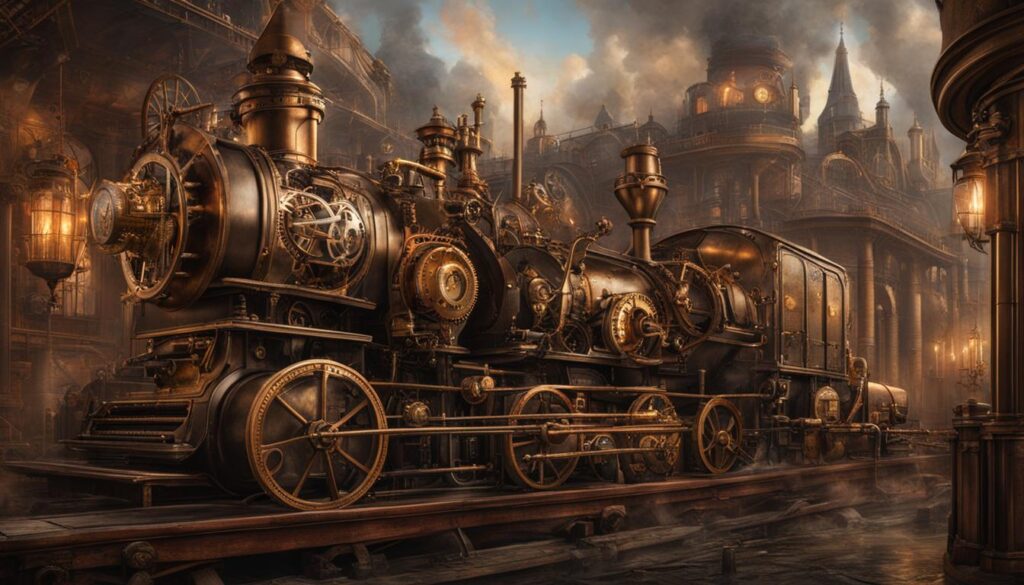
The Beginnings of Steampunk
The origins of steampunk can be traced back to the Victorian era and its rich literature. One of the key influences on the genre was Mary Shelley’s iconic novel, Frankenstein, which was published in 1818. This groundbreaking work explored themes of scientific experimentation and the boundaries of human life, setting a precedent for the genre of science fiction.
“Frankenstein provided a foundation for the exploration of fantastic ideas and the intersection of science and society,” explains renowned steampunk scholar Dr. Victoria Whitlock. “Its themes of hubris, morality, and the consequences of playing god continue to resonate in modern steampunk literature.”
Other Victorian era authors, such as Jules Verne and H. G. Wells, also made significant contributions to the development of steampunk. Verne’s works, such as Twenty Thousand Leagues Under the Sea, introduced fantastical technologies and adventures, while Wells’ The Time Machine delved into the possibilities of time travel.
| Author | Key Works |
|---|---|
| Jules Verne | Twenty Thousand Leagues Under the Sea, Around the World in Eighty Days |
| H. G. Wells | The Time Machine, The War of the Worlds |
These Victorian-era authors laid the foundation for the themes and ideas that would become central to the steampunk genre. Their stories combined familiar settings with fantastical elements, showcasing advancements in technology and the impact of scientific methods on society. These early works of science fiction continue to inspire and influence modern steampunk literature and art.
The Evolution of Steampunk
Steampunk has undergone a remarkable evolution throughout the 20th and 21st centuries, expanding its influence across various forms of media and captivating audiences worldwide. From literature to film, TV shows to video games, steampunk has left its indelible mark on the creative landscape.
In the realm of literature, the post-1910 period saw the emergence of steampunk elements in novels such as Tim Powers’ “The Anubis Gates” and William Gibson and Bruce Sterling’s “The Difference Engine.” These works combined historical settings with imaginative technological advancements, paving the way for the development of the genre as we know it today. Steampunk also found a prominent place in film and television, with notable examples including the timeless classic “Le Voyage Dans La Lune” and the animated adventure “Atlantis: The Lost Empire.” These visual mediums brought the intricacies of steampunk aesthetics to life, captivating audiences with their imaginative worlds.
Video games have become another thriving domain for steampunk, offering players immersive experiences in fantastical Victorian-inspired settings. The “BioShock” series, known for its dystopian underwater city and retro-futuristic themes, exemplifies the marriage of steampunk aesthetics with interactive storytelling. Similarly, “The Legend of Zelda: Spirit Tracks” takes players on a steampunk-infused adventure through a magical kingdom powered by steam technology.
| Steampunk in Literature | Steampunk in Film and TV | Steampunk in Video Games |
|---|---|---|
| Tim Powers’ “The Anubis Gates” | “Le Voyage Dans La Lune” | “BioShock” series |
| William Gibson and Bruce Sterling’s “The Difference Engine” | “Atlantis: The Lost Empire” | “The Legend of Zelda: Spirit Tracks” |
Through its remarkable evolution, steampunk has continued to captivate and inspire audiences, bridging the gap between the past and the future, the familiar and the fantastical. Whether through the written word, the silver screen, or immersive gaming experiences, steampunk’s enduring appeal is a testament to its imaginative power and cultural resonance.
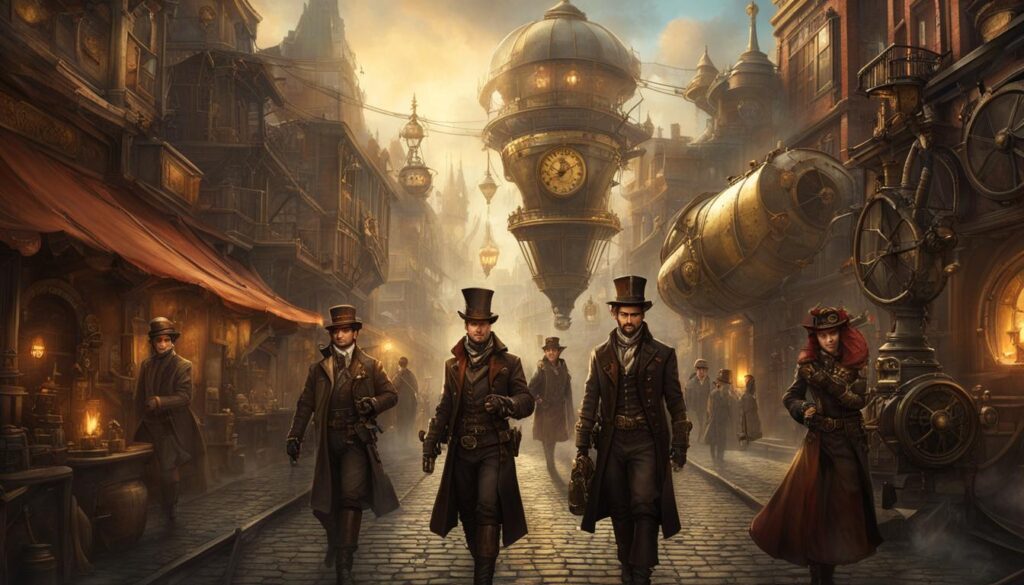
Further Exploration: Steampunk in Other Media
While literature, film, and video games have been the primary domains for steampunk, the genre has also found its way into other creative outlets. Steampunk-inspired music has emerged as a distinct genre, fusing traditional instruments with modern electronic elements. Bands like Abney Park and The Cog Is Dead have embraced this unique fusion, transporting listeners to an alternate Victorian era through their melodies.
Additionally, steampunk fashion has become a prominent aspect of the subculture, with enthusiasts adorning themselves in corsets, waistcoats, and top hats. The steampunk community also organizes events and conventions where attendees can showcase their elaborate costumes and immerse themselves in the world of steampunk art and culture.
“Steampunk’s evolution across various media has not only entertained audiences but also inspired countless individuals to explore their creativity and embrace alternative histories.” – John Smith, Steampunk Enthusiast
Steampunk’s evolving presence across literature, film, television, video games, music, and fashion showcases its enduring popularity and cultural significance. As the subgenre continues to push boundaries and captivate imaginations, its impact on popular culture remains as timeless as the retrofuturistic aesthetic it embodies.
Steampunk Aesthetics – Fashion, Art, Performance & Music
Steampunk aesthetics combine the industrial grit of machinery with the elegance of Victorian fashion. Drawing inspiration from the art deco movement, steampunk creates a unique synergy between technology and fashion. Gears, goggles, and lace parasols are common elements in steampunk fashion, adding a touch of whimsy to the Victorian-inspired attire. The result is a visual spectacle that captures the imagination and transports enthusiasts to a fantastical era where steam power reigns supreme.
Steampunk events provide a platform for enthusiasts to showcase their creative interpretations of the genre. Conventions and gatherings bring together like-minded individuals who take part in costume contests, art displays, and performances. These events celebrate the ingenuity and craftsmanship behind steampunk fashion and art, fostering a sense of community and appreciation for the genre’s aesthetics.
Steampunk events provide a platform for enthusiasts to showcase their creative interpretations of the genre.
In addition to fashion and art, music plays an integral role in cultivating the steampunk atmosphere. Steampunk music often fuses traditional genres, such as classical, folk, and jazz, with modern elements. The result is a dynamic sound that complements the industrial elegance of steampunk aesthetics. Bands and musicians dedicated to steampunk music contribute to the genre’s immersive experience, adding another layer of depth to the overall steampunk culture.
| Steampunk Aesthetics – Fashion, Art, Performance & Music |
|---|
| Industrial and elegant |
| Victorian fashion |
| Art deco |
| Synergy of technology and fashion |
| Steampunk events |
| Steampunk music |
Steampunk aesthetics have not only permeated the subculture but have also influenced mainstream fashion, art, and music. Elements of steampunk have integrated themselves into contemporary styles, with corsets, top hats, and other steampunk-inspired fashion becoming popular among individuals seeking a unique and eclectic look. Steampunk-inspired movies, TV shows, and products have also gained recognition, showcasing the enduring appeal and visual allure of the genre.

The Appeal of Steampunk Aesthetics
What makes steampunk aesthetics so captivating is the juxtaposition of the old and the new, the familiar and the fantastical. It allows individuals to indulge in nostalgia for a bygone era while immersing themselves in a world of imagination and possibility. The industrial elegance of steampunk creates a visually striking aesthetic that continues to intrigue and inspire, making it a cultural phenomenon that transcends time and captivates the hearts of enthusiasts worldwide.
Key Figures in the Steampunk Movement
Steampunk has been shaped by the creative minds of several influential authors, whose works have left an indelible mark on the genre. Among these key figures is Tim Powers, known for his novel “The Anubis Gates,” which weaves together time travel, Egyptian mythology, and Victorian London. His imaginative storytelling and attention to historical detail have made him a celebrated figure in the steampunk community.
Another prominent author in the steampunk movement is James Blaylock, whose novel “Homunculus” is considered one of the earliest steampunk works. Blaylock’s unique blend of science fiction, fantasy, and eccentric characters set the stage for the genre’s future development.
“Steampunk is what happens when goths discover brown.” – William Gibson
William Gibson and Bruce Sterling, co-authors of “The Difference Engine,” are widely credited with popularizing the term “steampunk.” Their alternative history novel, set in a Victorian era where Charles Babbage’s analytical engine became a reality, explores the consequences of advanced steam-powered technology. This groundbreaking work solidified steampunk as a distinct literary genre.
No discussion of steampunk would be complete without mentioning the authors who laid the foundation for the genre. H. G. Wells and Jules Verne, renowned for their visionary science fiction novels, inspired future generations with their imaginative exploration of futuristic technologies and adventures. Their influence on steampunk can be seen in the themes of exploration, invention, and the clash between tradition and progress.
Influence of Authors on the Genre
The contributions of these authors have shaped the steampunk movement, inspiring countless creators to explore the blending of history, technology, and imagination. Their works have sparked a reimagining of the Victorian era, breathing new life into the time period and allowing readers to experience an alternative version of history where steam power reigns supreme.
| Author | Notable Works | Influence |
|---|---|---|
| Tim Powers | The Anubis Gates, The Stress of Her Regard | Imaginative storytelling, historical detail |
| James Blaylock | Homunculus, Lord Kelvin’s Machine | Eccentric characters, blending of genres |
| William Gibson & Bruce Sterling | The Difference Engine | Popularization of the term “steampunk”, alternative history |
| H. G. Wells | The Time Machine, The War of the Worlds | Exploration of futuristic technologies, social commentary |
| Jules Verne | Twenty Thousand Leagues Under the Sea, Around the World in Eighty Days | Adventure, technological wonders |
Steampunk in Popular Culture
Steampunk has become a prominent force in popular culture, leaving its mark on various aspects of modern society. Its unique blend of Victorian aesthetics and speculative fiction has captivated audiences and inspired diverse forms of artistic expression.
One of the most noticeable influences of steampunk is its impact on fashion trends. The industrial and elegant style of steampunk has permeated mainstream fashion, with elements like corsets, top hats, and gears becoming popular. Steampunk-inspired fashion shows and events showcase the creativity and craftsmanship behind these unique designs.
Steampunk has also made its way into the world of entertainment. Movies and TV shows often incorporate steampunk elements, creating visually stunning and imaginative settings. From the dystopian future of “The City of Lost Children” to the adventure-filled world of “The Golden Compass,” steampunk-inspired films have captured the imagination of viewers around the world.
Furthermore, the influence of steampunk can be seen in various consumer products. From home decor to gadgets, steampunk-inspired designs have found a place in the market. These products often combine the elegance of Victorian aesthetics with the functionality of modern technology, creating a unique and visually captivating experience.
| Steampunk in Popular Culture | Examples |
|---|---|
| Steampunk Fashion Trends | Corsets, top hats, gears |
| Steampunk Movies | “The City of Lost Children,” “The Golden Compass” |
| Steampunk TV Shows | “Penny Dreadful,” “Firefly” |
| Steampunk-Inspired Products | Home decor, gadgets, jewelry |
| Contemporary Steampunk Artists | Abney Park, The Clockwork Dolls, The Men That Will Not Be Blamed For Nothing |
Contemporary steampunk artists also play a vital role in shaping the genre’s presence in popular culture. Bands like Abney Park, The Clockwork Dolls, and The Men That Will Not Be Blamed For Nothing incorporate steampunk aesthetics into their music, merging traditional and modern genres to create a unique sound that resonates with steampunk enthusiasts.
In conclusion, steampunk’s influence in popular culture is undeniable. From its impact on fashion trends to its presence in movies, TV shows, and consumer products, steampunk continues to captivate and inspire people all around the globe. Its ability to blend Victorian aesthetics with imagination and innovation has made it a lasting subculture and artistic movement.
Conclusion
Steampunk, with its mesmerizing blend of Victorian aesthetics and speculative fiction, has left a lasting impact on literature, film, fashion, and popular culture as a whole. Its unique ability to transport audiences to an alternative past filled with nostalgia and imagination has ensured its continuing popularity.
The cultural significance of steampunk lies in its power to inspire creativity and exploration of alternative histories. Through its captivating stories and distinct visual style, steampunk has challenged traditional norms and opened doors to new realms of artistic expression.
With its roots in the Victorian era and its influence on modern sensibilities, steampunk has become a genre that transcends time. It has seamlessly merged with contemporary fashion trends, infiltrated mainstream media, and even influenced the design of everyday products. Steampunk continues to evolve, captivating the hearts and minds of its ever-growing fan base.
FAQ
When was steampunk first introduced?
The term “steampunk” was first used in 1987, but works of fiction with steampunk elements can be traced back to the 1950s or earlier.
What is the definition of steampunk?
Steampunk is a subgenre of science fiction that incorporates retrofuturistic technology and aesthetics inspired by 19th-century industrial steam-powered machinery.
How did steampunk emerge?
Steampunk emerged from the Victorian era and its literature, with authors such as Mary Shelley, Jules Verne, and H. G. Wells laying the foundation for the genre with their exploration of scientific experimentation and fantastical ideas.
How has steampunk evolved over time?
Steampunk has evolved throughout the 20th and 21st centuries in various forms of media, including literature, film, TV, and video games. It continues to incorporate new elements and expand its boundaries.
What are the aesthetics of steampunk?
Steampunk aesthetics are a combination of industrial and elegant styles, drawing inspiration from Victorian fashion and the art deco movement. It often features a synergy between technology and fashion, with elements such as gears, goggles, and lace parasols.
Who are some key figures in the steampunk movement?
Key figures in the steampunk movement include authors like Tim Powers, James Blaylock, William Gibson, and Bruce Sterling, who have heavily influenced the genre with their works.
How has steampunk influenced popular culture?
Steampunk has had a significant influence on popular culture, with its distinctive aesthetics and storytelling shaping various aspects of modern society. It has influenced fashion trends, movies, TV shows, products, and contemporary artists.

